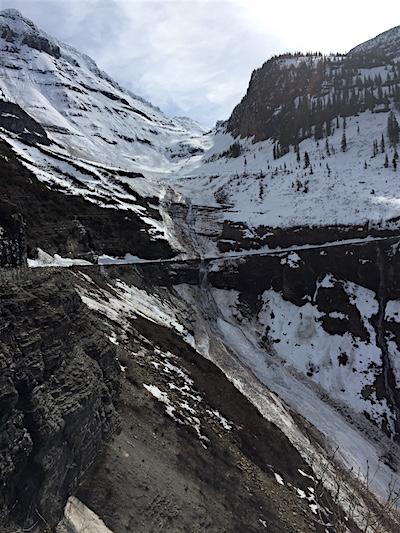
A "glide" avalanche below Haystack Peak set back progress on clearing snow from the Going to the Sun Road in Glacier National Park/NPS
Memorial Day weekend is still weeks away, but winter slowly is releasing its grip on Glacier National Park in Montana, where the Many Glacier and Chief Mountain roads have been opened to vehicles for the summer. Visitors are welcome to drive the 8-mile Many Glacier Road as far as the Many Glacier Campground. The Swiftcurrent Nature Trail loop on the valley floor is open in its entirety with parking available at Grinnell Picnic area.
Currently, no services are available along the Many Glacier Road with the exception of pit toilets at the ranger station and picnic area. The access road to the Many Glacier Hotel is closed due to construction at the hotel. Temporary parking for hotel trailheads is available along Many Glacier Road at the “T” junction with the road to the hotel. To access trailheads beyond the hotel, visitors should follow posted signs from the junction and stay clear of the posted construction zone.
On both the east and west sides of the Going-to-the-Sun Road, avalanche concerns have prevented plowing operations from advancing since last Wednesday. Park officials are recommending that hikers and bikers use caution if they plan to travel on the road.
Sometime between Wednesday afternoon and Thursday morning two large glide avalanches released at Haystack and Heaven’s Gate, according to a park avalanche report. Both of these were large magnitude events with the debris running several thousand feet down into the valley bottoms. The avalanche at Haystack is blocking the Sun Road where road crews had previously plowed the road, and debris is plugging the stone archway that spans Haystack Creek.
West side plowing crews discovered the 30-foot deep avalanche debris at Haystack on their way up to plow the road on Thursday morning. Due to continued avalanche danger, the crew returned to complete road work at lower elevations without plowing further up the road.
Official REI Coupons and Rebates page
On the west side of the park, visitors can drive the Camas Road and the first 11.5 miles of the Going to the Sun Road from the park entrance to Lake McDonald Lodge. Beyond the lodge, people on foot or on bicycles can continue up the traffic-free road for another 12 miles to the Loop where the hiker/biker sign is currently located.
On the east side of the park, vehicles may drive the first 5.5 miles of the Sun Road from St. Mary entrance to Rising Sun. Beyond that gate, hikers and bicyclists may continue on the road as far as Siyeh Bend. For at least the next few days, travel beyond Siyeh Bend is not advised due to avalanche danger. Two Medicine Road is closed to vehicles at Running Eagle Falls, with no restrictions for hikers and bikers beyond that point.
In addition to avalanche concerns, hikers and bikers are reminded that bears have emerged from their dens and that precautions are advised, including carrying bear spray and making noise along roads and trails where visibility is restricted. Recreationists should be prepared for variable spring conditions including mud, snow and patches of ice both on roads and trails.
Since road conditions and openings change frequently this time of year please visit the park’s webpage or check the park’s social media sites or call 406-888-7800 for the latest information. On weekends, visitors can stop at the Apgar Visitor Center from 9 a.m. to 4:30 p.m. for the latest information.



Add comment